Human Resources Management: Revamping HR Activities for Employee Engagement
VerifiedAdded on 2022/11/23
|16
|3693
|431
AI Summary
This project discusses a range of human resources activities that impact employee engagement in the context of a case study hotel with low employee engagement level. It suggests revamping the vision, mission and values statement, creating a new orientation program, learning and development programs, and employee incentive program. The report includes a table of contents, introduction to the hotel, orientation overview, induction activity brief, learning and development overview, wellness programs, and acknowledgement/enrichment program.
Contribute Materials
Your contribution can guide someone’s learning journey. Share your
documents today.
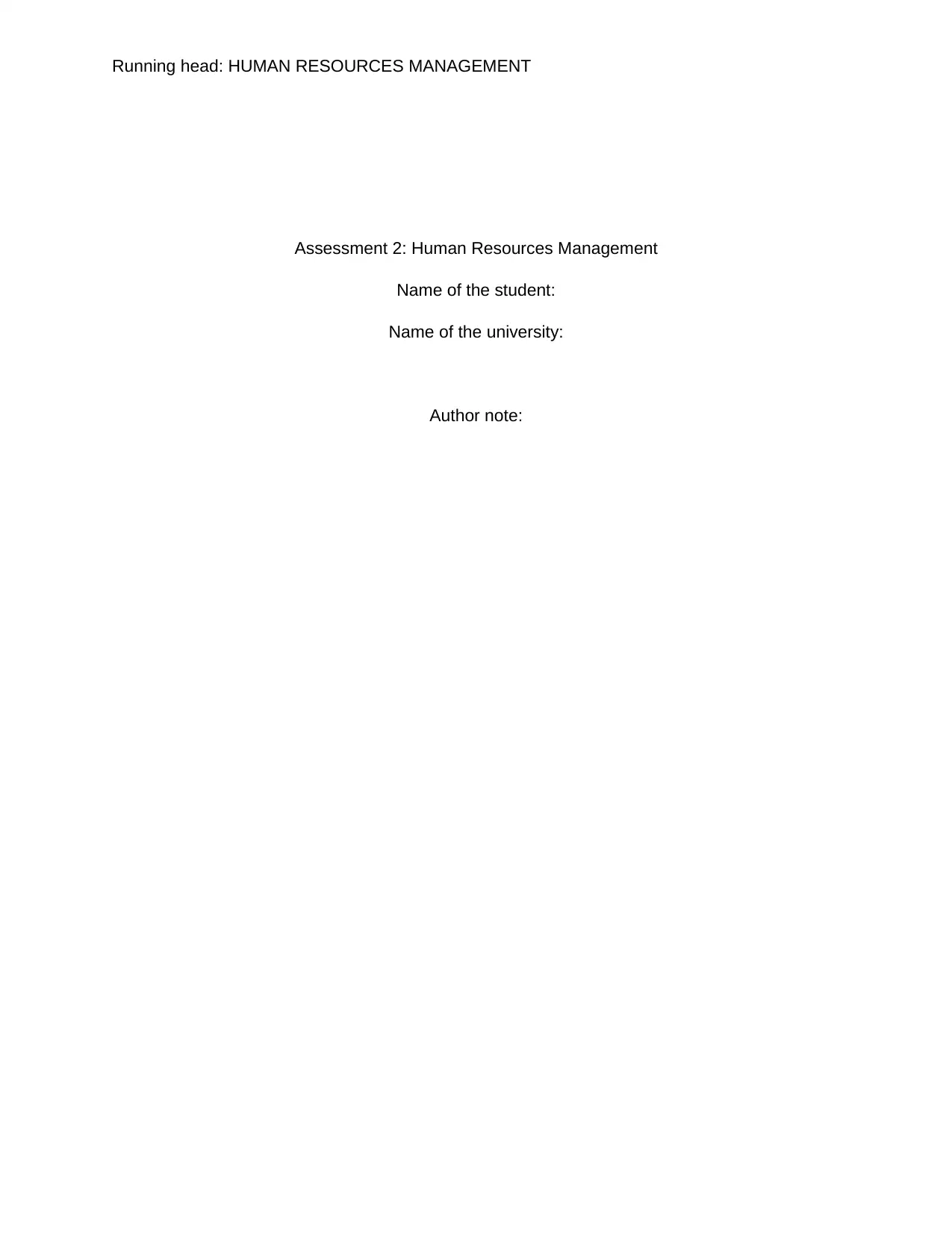
Running head: HUMAN RESOURCES MANAGEMENT
Assessment 2: Human Resources Management
Name of the student:
Name of the university:
Author note:
Assessment 2: Human Resources Management
Name of the student:
Name of the university:
Author note:
Secure Best Marks with AI Grader
Need help grading? Try our AI Grader for instant feedback on your assignments.
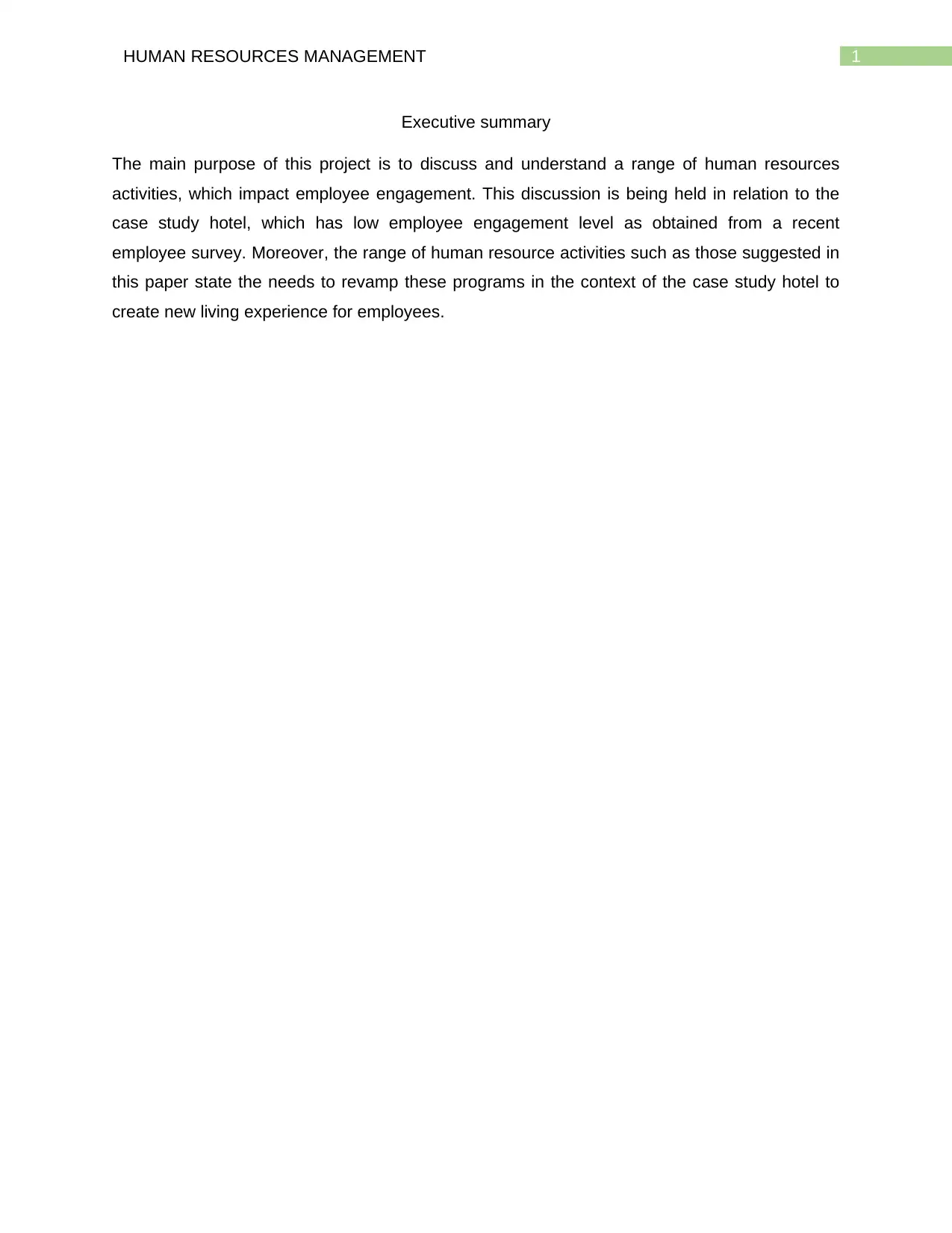
1HUMAN RESOURCES MANAGEMENT
Executive summary
The main purpose of this project is to discuss and understand a range of human resources
activities, which impact employee engagement. This discussion is being held in relation to the
case study hotel, which has low employee engagement level as obtained from a recent
employee survey. Moreover, the range of human resource activities such as those suggested in
this paper state the needs to revamp these programs in the context of the case study hotel to
create new living experience for employees.
Executive summary
The main purpose of this project is to discuss and understand a range of human resources
activities, which impact employee engagement. This discussion is being held in relation to the
case study hotel, which has low employee engagement level as obtained from a recent
employee survey. Moreover, the range of human resource activities such as those suggested in
this paper state the needs to revamp these programs in the context of the case study hotel to
create new living experience for employees.
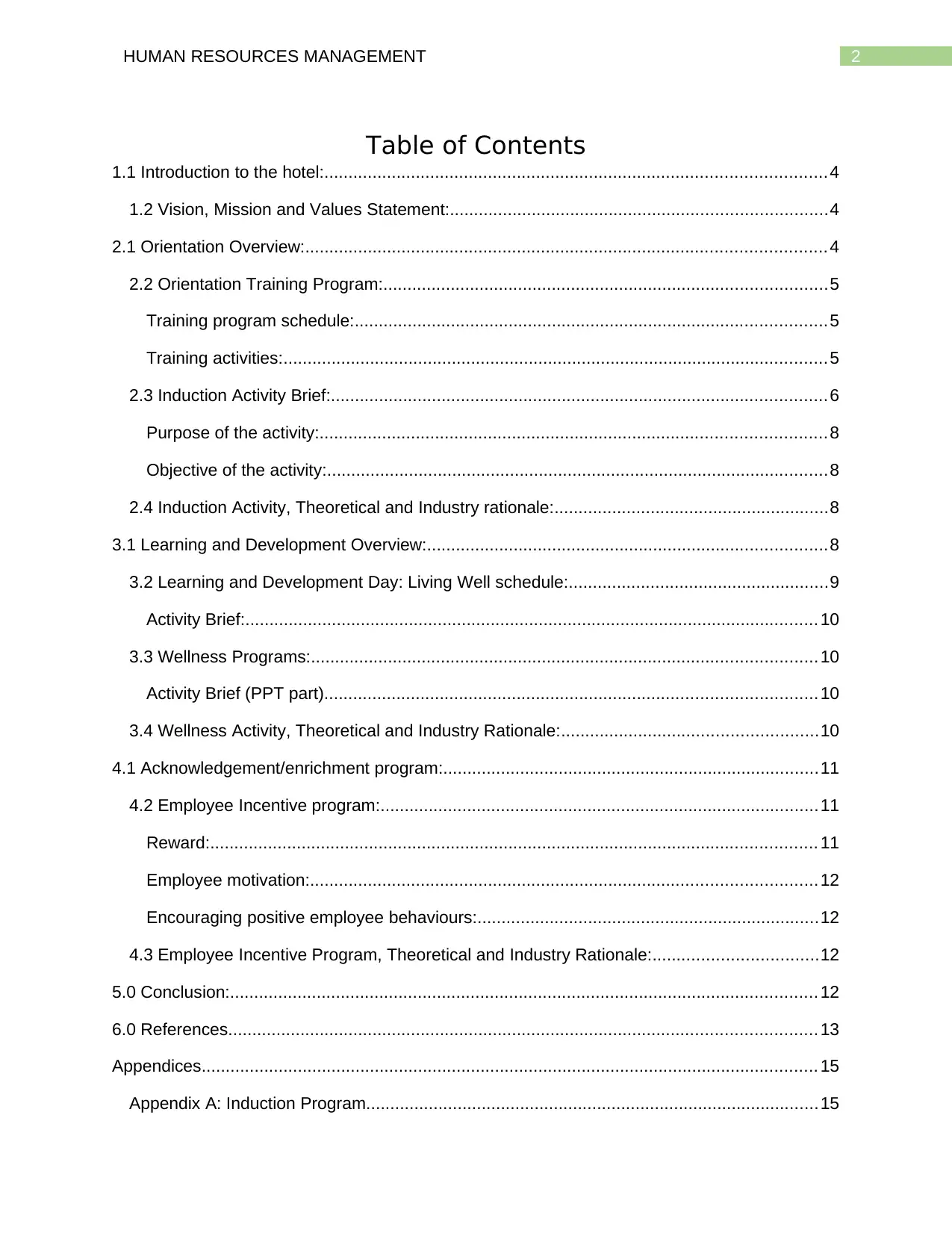
2HUMAN RESOURCES MANAGEMENT
Table of Contents
1.1 Introduction to the hotel:........................................................................................................4
1.2 Vision, Mission and Values Statement:..............................................................................4
2.1 Orientation Overview:............................................................................................................ 4
2.2 Orientation Training Program:............................................................................................5
Training program schedule:..................................................................................................5
Training activities:.................................................................................................................5
2.3 Induction Activity Brief:.......................................................................................................6
Purpose of the activity:.........................................................................................................8
Objective of the activity:........................................................................................................8
2.4 Induction Activity, Theoretical and Industry rationale:.........................................................8
3.1 Learning and Development Overview:...................................................................................8
3.2 Learning and Development Day: Living Well schedule:......................................................9
Activity Brief:....................................................................................................................... 10
3.3 Wellness Programs:.........................................................................................................10
Activity Brief (PPT part)......................................................................................................10
3.4 Wellness Activity, Theoretical and Industry Rationale:.....................................................10
4.1 Acknowledgement/enrichment program:..............................................................................11
4.2 Employee Incentive program:...........................................................................................11
Reward:.............................................................................................................................. 11
Employee motivation:.........................................................................................................12
Encouraging positive employee behaviours:.......................................................................12
4.3 Employee Incentive Program, Theoretical and Industry Rationale:..................................12
5.0 Conclusion:.......................................................................................................................... 12
6.0 References.......................................................................................................................... 13
Appendices................................................................................................................................ 15
Appendix A: Induction Program..............................................................................................15
Table of Contents
1.1 Introduction to the hotel:........................................................................................................4
1.2 Vision, Mission and Values Statement:..............................................................................4
2.1 Orientation Overview:............................................................................................................ 4
2.2 Orientation Training Program:............................................................................................5
Training program schedule:..................................................................................................5
Training activities:.................................................................................................................5
2.3 Induction Activity Brief:.......................................................................................................6
Purpose of the activity:.........................................................................................................8
Objective of the activity:........................................................................................................8
2.4 Induction Activity, Theoretical and Industry rationale:.........................................................8
3.1 Learning and Development Overview:...................................................................................8
3.2 Learning and Development Day: Living Well schedule:......................................................9
Activity Brief:....................................................................................................................... 10
3.3 Wellness Programs:.........................................................................................................10
Activity Brief (PPT part)......................................................................................................10
3.4 Wellness Activity, Theoretical and Industry Rationale:.....................................................10
4.1 Acknowledgement/enrichment program:..............................................................................11
4.2 Employee Incentive program:...........................................................................................11
Reward:.............................................................................................................................. 11
Employee motivation:.........................................................................................................12
Encouraging positive employee behaviours:.......................................................................12
4.3 Employee Incentive Program, Theoretical and Industry Rationale:..................................12
5.0 Conclusion:.......................................................................................................................... 12
6.0 References.......................................................................................................................... 13
Appendices................................................................................................................................ 15
Appendix A: Induction Program..............................................................................................15
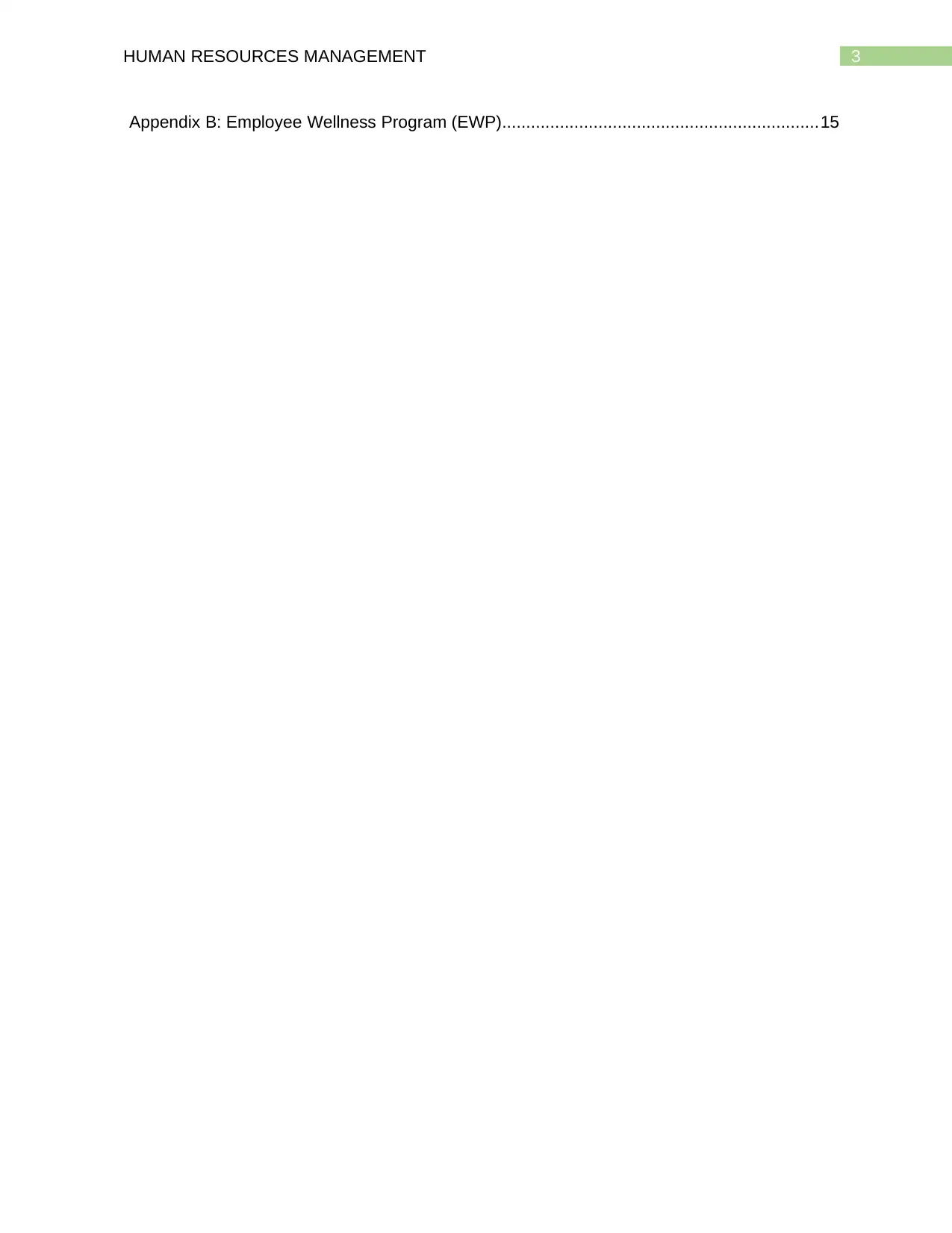
3HUMAN RESOURCES MANAGEMENT
Appendix B: Employee Wellness Program (EWP)..................................................................15
Appendix B: Employee Wellness Program (EWP)..................................................................15
Secure Best Marks with AI Grader
Need help grading? Try our AI Grader for instant feedback on your assignments.
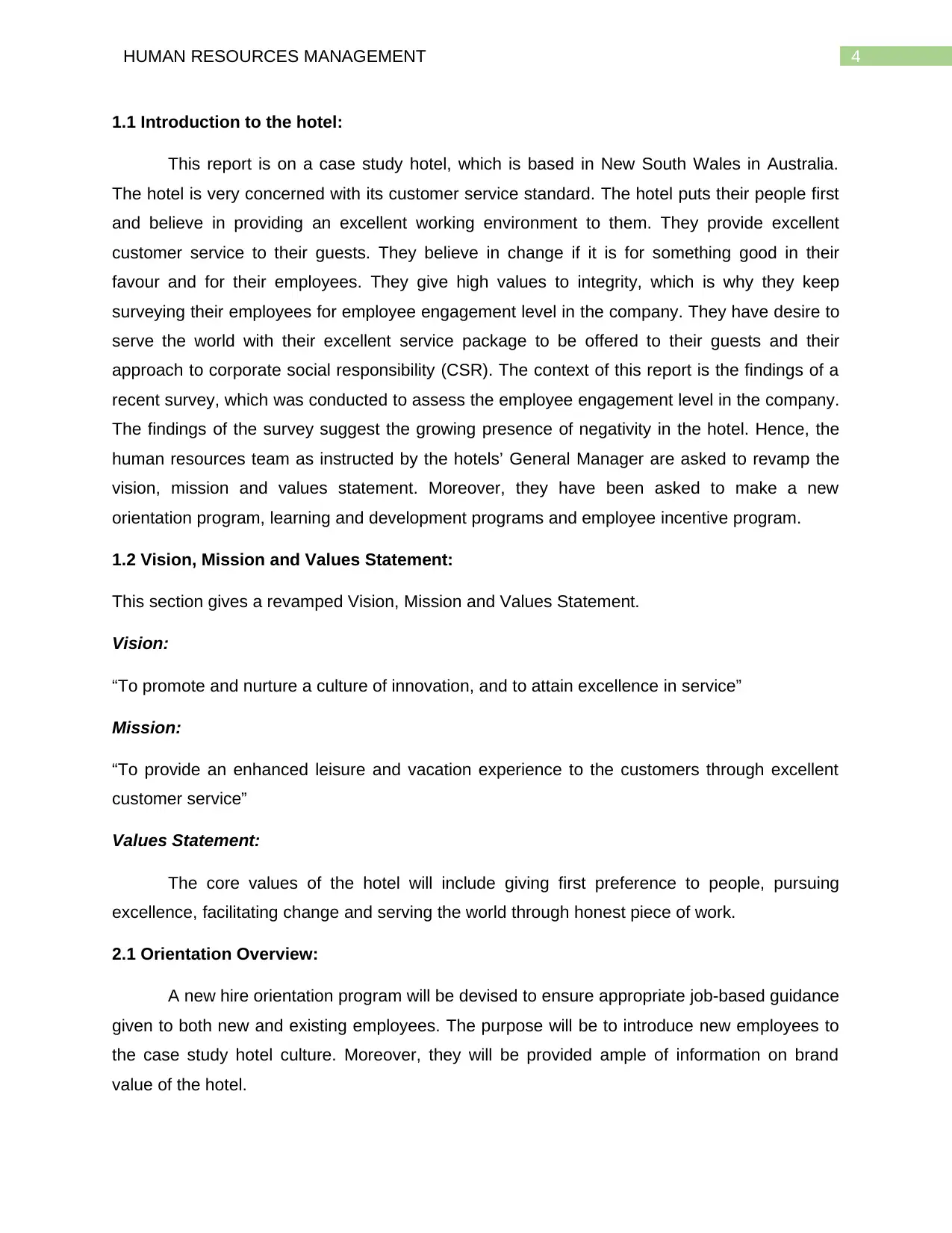
4HUMAN RESOURCES MANAGEMENT
1.1 Introduction to the hotel:
This report is on a case study hotel, which is based in New South Wales in Australia.
The hotel is very concerned with its customer service standard. The hotel puts their people first
and believe in providing an excellent working environment to them. They provide excellent
customer service to their guests. They believe in change if it is for something good in their
favour and for their employees. They give high values to integrity, which is why they keep
surveying their employees for employee engagement level in the company. They have desire to
serve the world with their excellent service package to be offered to their guests and their
approach to corporate social responsibility (CSR). The context of this report is the findings of a
recent survey, which was conducted to assess the employee engagement level in the company.
The findings of the survey suggest the growing presence of negativity in the hotel. Hence, the
human resources team as instructed by the hotels’ General Manager are asked to revamp the
vision, mission and values statement. Moreover, they have been asked to make a new
orientation program, learning and development programs and employee incentive program.
1.2 Vision, Mission and Values Statement:
This section gives a revamped Vision, Mission and Values Statement.
Vision:
“To promote and nurture a culture of innovation, and to attain excellence in service”
Mission:
“To provide an enhanced leisure and vacation experience to the customers through excellent
customer service”
Values Statement:
The core values of the hotel will include giving first preference to people, pursuing
excellence, facilitating change and serving the world through honest piece of work.
2.1 Orientation Overview:
A new hire orientation program will be devised to ensure appropriate job-based guidance
given to both new and existing employees. The purpose will be to introduce new employees to
the case study hotel culture. Moreover, they will be provided ample of information on brand
value of the hotel.
1.1 Introduction to the hotel:
This report is on a case study hotel, which is based in New South Wales in Australia.
The hotel is very concerned with its customer service standard. The hotel puts their people first
and believe in providing an excellent working environment to them. They provide excellent
customer service to their guests. They believe in change if it is for something good in their
favour and for their employees. They give high values to integrity, which is why they keep
surveying their employees for employee engagement level in the company. They have desire to
serve the world with their excellent service package to be offered to their guests and their
approach to corporate social responsibility (CSR). The context of this report is the findings of a
recent survey, which was conducted to assess the employee engagement level in the company.
The findings of the survey suggest the growing presence of negativity in the hotel. Hence, the
human resources team as instructed by the hotels’ General Manager are asked to revamp the
vision, mission and values statement. Moreover, they have been asked to make a new
orientation program, learning and development programs and employee incentive program.
1.2 Vision, Mission and Values Statement:
This section gives a revamped Vision, Mission and Values Statement.
Vision:
“To promote and nurture a culture of innovation, and to attain excellence in service”
Mission:
“To provide an enhanced leisure and vacation experience to the customers through excellent
customer service”
Values Statement:
The core values of the hotel will include giving first preference to people, pursuing
excellence, facilitating change and serving the world through honest piece of work.
2.1 Orientation Overview:
A new hire orientation program will be devised to ensure appropriate job-based guidance
given to both new and existing employees. The purpose will be to introduce new employees to
the case study hotel culture. Moreover, they will be provided ample of information on brand
value of the hotel.
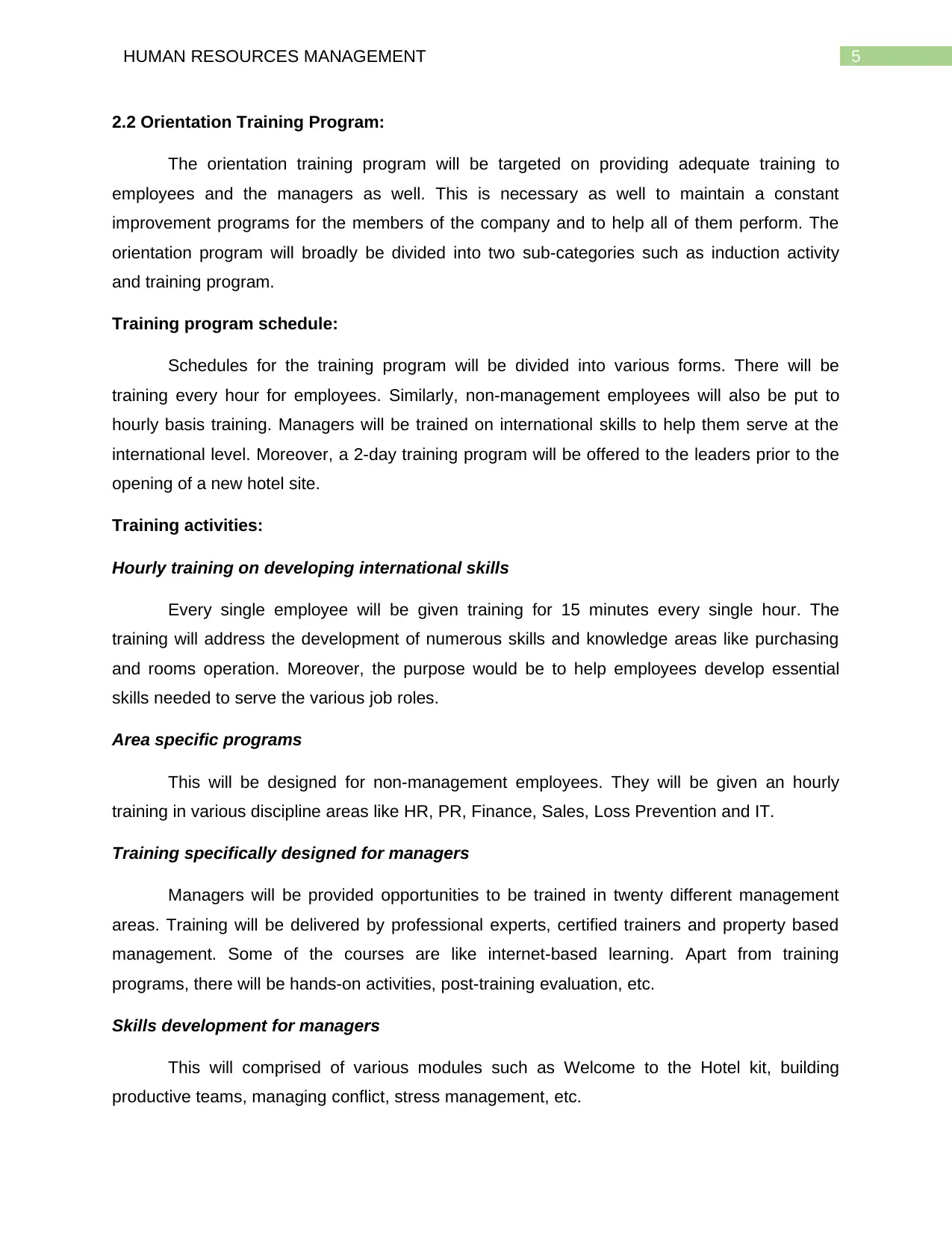
5HUMAN RESOURCES MANAGEMENT
2.2 Orientation Training Program:
The orientation training program will be targeted on providing adequate training to
employees and the managers as well. This is necessary as well to maintain a constant
improvement programs for the members of the company and to help all of them perform. The
orientation program will broadly be divided into two sub-categories such as induction activity
and training program.
Training program schedule:
Schedules for the training program will be divided into various forms. There will be
training every hour for employees. Similarly, non-management employees will also be put to
hourly basis training. Managers will be trained on international skills to help them serve at the
international level. Moreover, a 2-day training program will be offered to the leaders prior to the
opening of a new hotel site.
Training activities:
Hourly training on developing international skills
Every single employee will be given training for 15 minutes every single hour. The
training will address the development of numerous skills and knowledge areas like purchasing
and rooms operation. Moreover, the purpose would be to help employees develop essential
skills needed to serve the various job roles.
Area specific programs
This will be designed for non-management employees. They will be given an hourly
training in various discipline areas like HR, PR, Finance, Sales, Loss Prevention and IT.
Training specifically designed for managers
Managers will be provided opportunities to be trained in twenty different management
areas. Training will be delivered by professional experts, certified trainers and property based
management. Some of the courses are like internet-based learning. Apart from training
programs, there will be hands-on activities, post-training evaluation, etc.
Skills development for managers
This will comprised of various modules such as Welcome to the Hotel kit, building
productive teams, managing conflict, stress management, etc.
2.2 Orientation Training Program:
The orientation training program will be targeted on providing adequate training to
employees and the managers as well. This is necessary as well to maintain a constant
improvement programs for the members of the company and to help all of them perform. The
orientation program will broadly be divided into two sub-categories such as induction activity
and training program.
Training program schedule:
Schedules for the training program will be divided into various forms. There will be
training every hour for employees. Similarly, non-management employees will also be put to
hourly basis training. Managers will be trained on international skills to help them serve at the
international level. Moreover, a 2-day training program will be offered to the leaders prior to the
opening of a new hotel site.
Training activities:
Hourly training on developing international skills
Every single employee will be given training for 15 minutes every single hour. The
training will address the development of numerous skills and knowledge areas like purchasing
and rooms operation. Moreover, the purpose would be to help employees develop essential
skills needed to serve the various job roles.
Area specific programs
This will be designed for non-management employees. They will be given an hourly
training in various discipline areas like HR, PR, Finance, Sales, Loss Prevention and IT.
Training specifically designed for managers
Managers will be provided opportunities to be trained in twenty different management
areas. Training will be delivered by professional experts, certified trainers and property based
management. Some of the courses are like internet-based learning. Apart from training
programs, there will be hands-on activities, post-training evaluation, etc.
Skills development for managers
This will comprised of various modules such as Welcome to the Hotel kit, building
productive teams, managing conflict, stress management, etc.
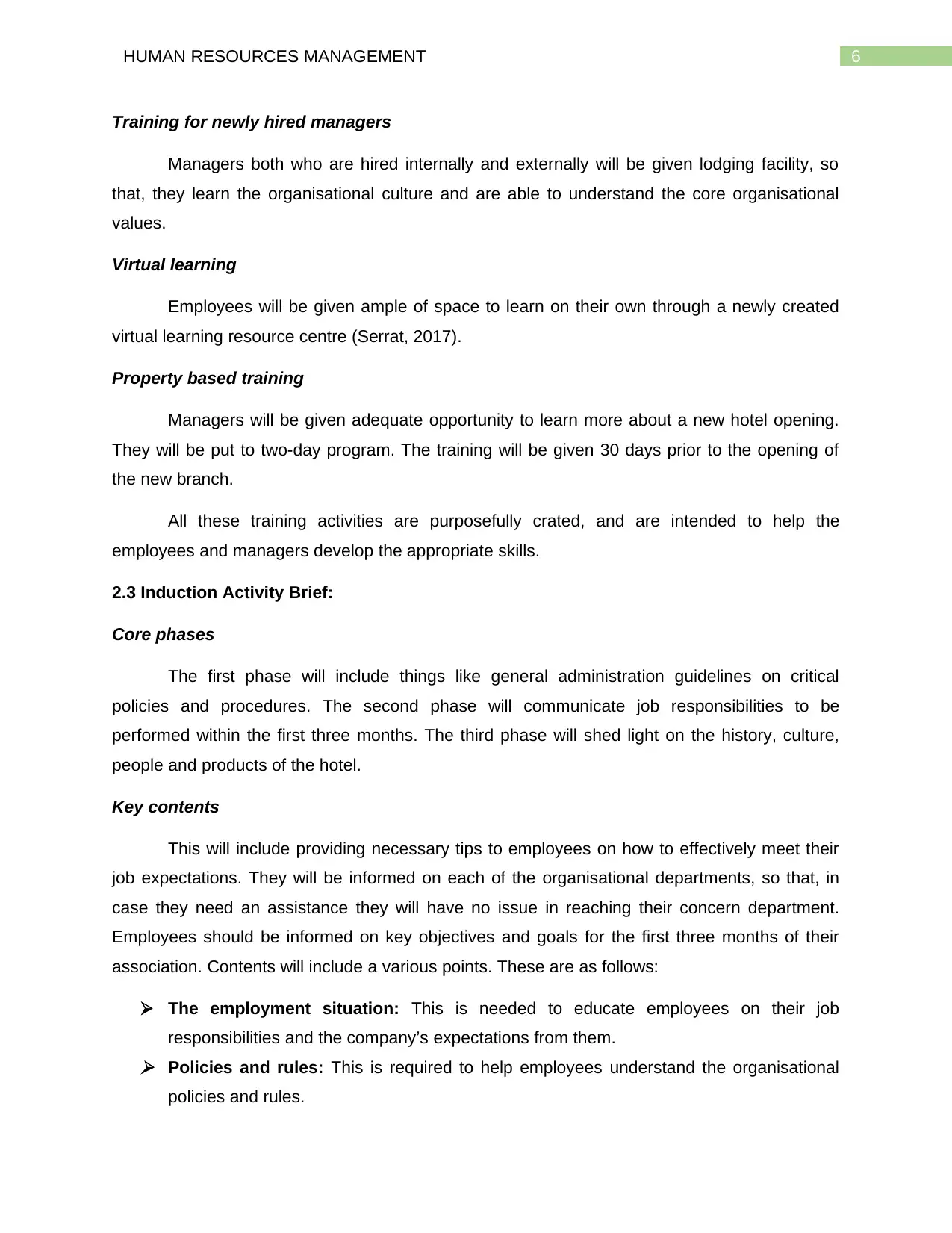
6HUMAN RESOURCES MANAGEMENT
Training for newly hired managers
Managers both who are hired internally and externally will be given lodging facility, so
that, they learn the organisational culture and are able to understand the core organisational
values.
Virtual learning
Employees will be given ample of space to learn on their own through a newly created
virtual learning resource centre (Serrat, 2017).
Property based training
Managers will be given adequate opportunity to learn more about a new hotel opening.
They will be put to two-day program. The training will be given 30 days prior to the opening of
the new branch.
All these training activities are purposefully crated, and are intended to help the
employees and managers develop the appropriate skills.
2.3 Induction Activity Brief:
Core phases
The first phase will include things like general administration guidelines on critical
policies and procedures. The second phase will communicate job responsibilities to be
performed within the first three months. The third phase will shed light on the history, culture,
people and products of the hotel.
Key contents
This will include providing necessary tips to employees on how to effectively meet their
job expectations. They will be informed on each of the organisational departments, so that, in
case they need an assistance they will have no issue in reaching their concern department.
Employees should be informed on key objectives and goals for the first three months of their
association. Contents will include a various points. These are as follows:
The employment situation: This is needed to educate employees on their job
responsibilities and the company’s expectations from them. Policies and rules: This is required to help employees understand the organisational
policies and rules.
Training for newly hired managers
Managers both who are hired internally and externally will be given lodging facility, so
that, they learn the organisational culture and are able to understand the core organisational
values.
Virtual learning
Employees will be given ample of space to learn on their own through a newly created
virtual learning resource centre (Serrat, 2017).
Property based training
Managers will be given adequate opportunity to learn more about a new hotel opening.
They will be put to two-day program. The training will be given 30 days prior to the opening of
the new branch.
All these training activities are purposefully crated, and are intended to help the
employees and managers develop the appropriate skills.
2.3 Induction Activity Brief:
Core phases
The first phase will include things like general administration guidelines on critical
policies and procedures. The second phase will communicate job responsibilities to be
performed within the first three months. The third phase will shed light on the history, culture,
people and products of the hotel.
Key contents
This will include providing necessary tips to employees on how to effectively meet their
job expectations. They will be informed on each of the organisational departments, so that, in
case they need an assistance they will have no issue in reaching their concern department.
Employees should be informed on key objectives and goals for the first three months of their
association. Contents will include a various points. These are as follows:
The employment situation: This is needed to educate employees on their job
responsibilities and the company’s expectations from them. Policies and rules: This is required to help employees understand the organisational
policies and rules.
Paraphrase This Document
Need a fresh take? Get an instant paraphrase of this document with our AI Paraphraser
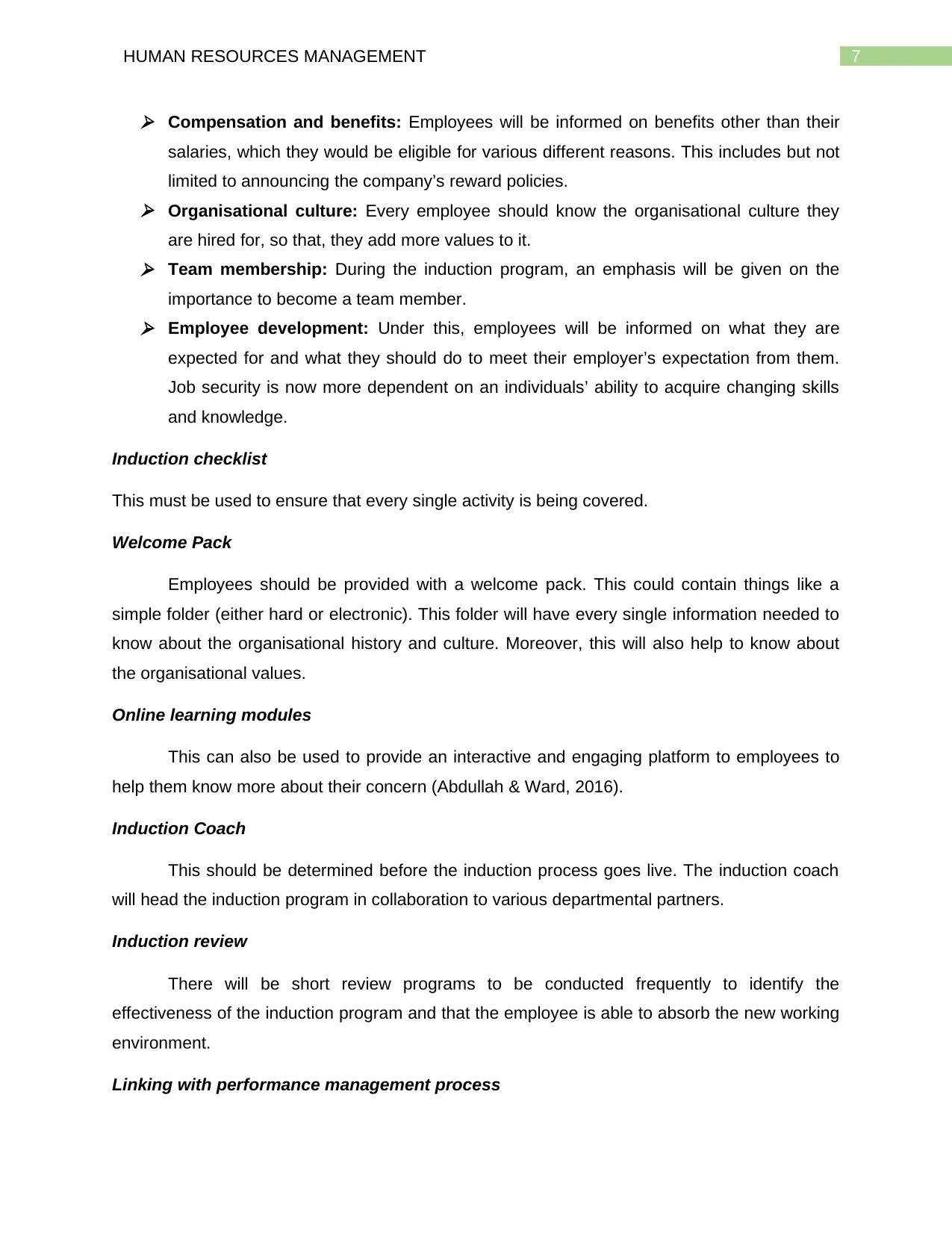
7HUMAN RESOURCES MANAGEMENT
Compensation and benefits: Employees will be informed on benefits other than their
salaries, which they would be eligible for various different reasons. This includes but not
limited to announcing the company’s reward policies. Organisational culture: Every employee should know the organisational culture they
are hired for, so that, they add more values to it. Team membership: During the induction program, an emphasis will be given on the
importance to become a team member. Employee development: Under this, employees will be informed on what they are
expected for and what they should do to meet their employer’s expectation from them.
Job security is now more dependent on an individuals’ ability to acquire changing skills
and knowledge.
Induction checklist
This must be used to ensure that every single activity is being covered.
Welcome Pack
Employees should be provided with a welcome pack. This could contain things like a
simple folder (either hard or electronic). This folder will have every single information needed to
know about the organisational history and culture. Moreover, this will also help to know about
the organisational values.
Online learning modules
This can also be used to provide an interactive and engaging platform to employees to
help them know more about their concern (Abdullah & Ward, 2016).
Induction Coach
This should be determined before the induction process goes live. The induction coach
will head the induction program in collaboration to various departmental partners.
Induction review
There will be short review programs to be conducted frequently to identify the
effectiveness of the induction program and that the employee is able to absorb the new working
environment.
Linking with performance management process
Compensation and benefits: Employees will be informed on benefits other than their
salaries, which they would be eligible for various different reasons. This includes but not
limited to announcing the company’s reward policies. Organisational culture: Every employee should know the organisational culture they
are hired for, so that, they add more values to it. Team membership: During the induction program, an emphasis will be given on the
importance to become a team member. Employee development: Under this, employees will be informed on what they are
expected for and what they should do to meet their employer’s expectation from them.
Job security is now more dependent on an individuals’ ability to acquire changing skills
and knowledge.
Induction checklist
This must be used to ensure that every single activity is being covered.
Welcome Pack
Employees should be provided with a welcome pack. This could contain things like a
simple folder (either hard or electronic). This folder will have every single information needed to
know about the organisational history and culture. Moreover, this will also help to know about
the organisational values.
Online learning modules
This can also be used to provide an interactive and engaging platform to employees to
help them know more about their concern (Abdullah & Ward, 2016).
Induction Coach
This should be determined before the induction process goes live. The induction coach
will head the induction program in collaboration to various departmental partners.
Induction review
There will be short review programs to be conducted frequently to identify the
effectiveness of the induction program and that the employee is able to absorb the new working
environment.
Linking with performance management process
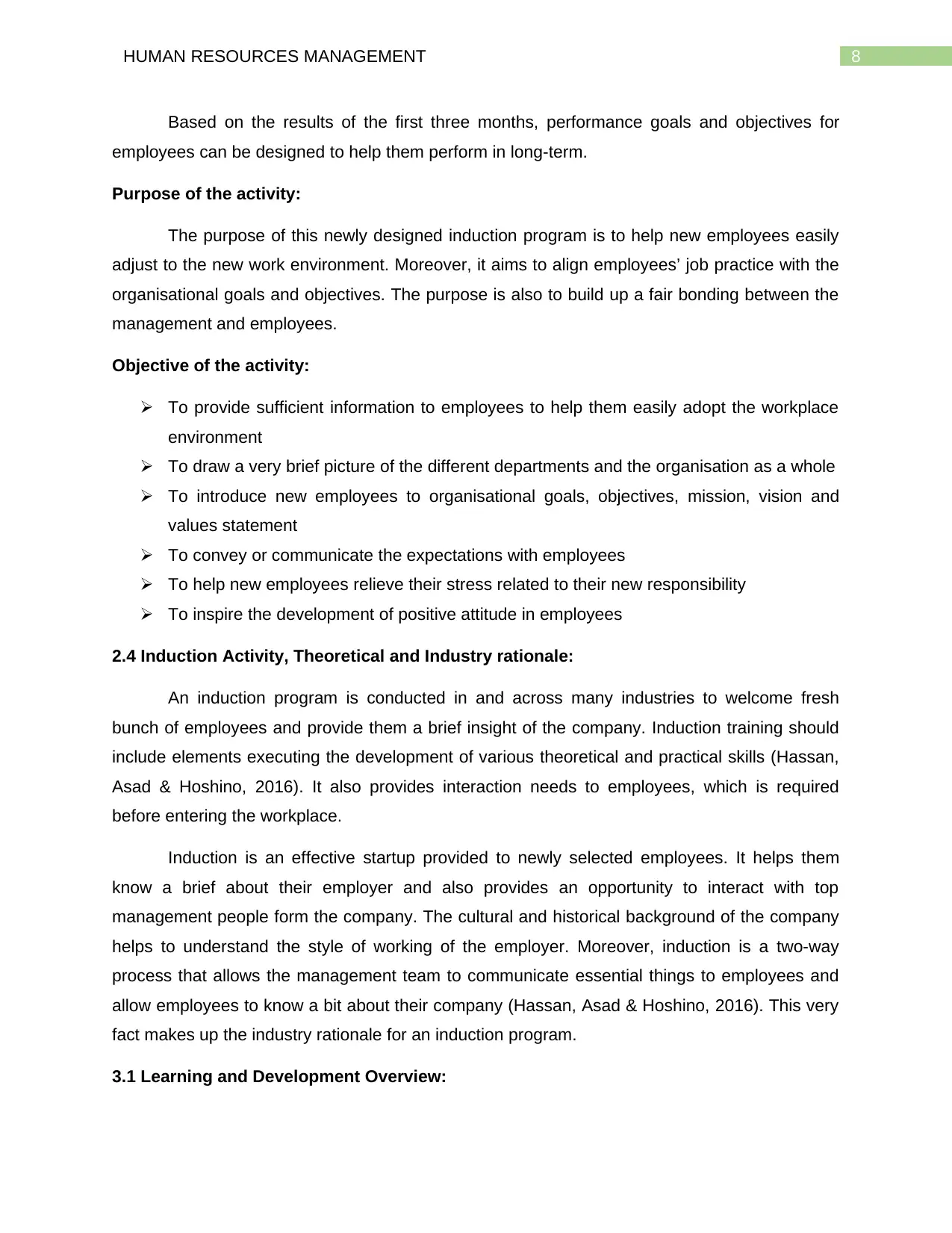
8HUMAN RESOURCES MANAGEMENT
Based on the results of the first three months, performance goals and objectives for
employees can be designed to help them perform in long-term.
Purpose of the activity:
The purpose of this newly designed induction program is to help new employees easily
adjust to the new work environment. Moreover, it aims to align employees’ job practice with the
organisational goals and objectives. The purpose is also to build up a fair bonding between the
management and employees.
Objective of the activity:
To provide sufficient information to employees to help them easily adopt the workplace
environment
To draw a very brief picture of the different departments and the organisation as a whole
To introduce new employees to organisational goals, objectives, mission, vision and
values statement
To convey or communicate the expectations with employees
To help new employees relieve their stress related to their new responsibility
To inspire the development of positive attitude in employees
2.4 Induction Activity, Theoretical and Industry rationale:
An induction program is conducted in and across many industries to welcome fresh
bunch of employees and provide them a brief insight of the company. Induction training should
include elements executing the development of various theoretical and practical skills (Hassan,
Asad & Hoshino, 2016). It also provides interaction needs to employees, which is required
before entering the workplace.
Induction is an effective startup provided to newly selected employees. It helps them
know a brief about their employer and also provides an opportunity to interact with top
management people form the company. The cultural and historical background of the company
helps to understand the style of working of the employer. Moreover, induction is a two-way
process that allows the management team to communicate essential things to employees and
allow employees to know a bit about their company (Hassan, Asad & Hoshino, 2016). This very
fact makes up the industry rationale for an induction program.
3.1 Learning and Development Overview:
Based on the results of the first three months, performance goals and objectives for
employees can be designed to help them perform in long-term.
Purpose of the activity:
The purpose of this newly designed induction program is to help new employees easily
adjust to the new work environment. Moreover, it aims to align employees’ job practice with the
organisational goals and objectives. The purpose is also to build up a fair bonding between the
management and employees.
Objective of the activity:
To provide sufficient information to employees to help them easily adopt the workplace
environment
To draw a very brief picture of the different departments and the organisation as a whole
To introduce new employees to organisational goals, objectives, mission, vision and
values statement
To convey or communicate the expectations with employees
To help new employees relieve their stress related to their new responsibility
To inspire the development of positive attitude in employees
2.4 Induction Activity, Theoretical and Industry rationale:
An induction program is conducted in and across many industries to welcome fresh
bunch of employees and provide them a brief insight of the company. Induction training should
include elements executing the development of various theoretical and practical skills (Hassan,
Asad & Hoshino, 2016). It also provides interaction needs to employees, which is required
before entering the workplace.
Induction is an effective startup provided to newly selected employees. It helps them
know a brief about their employer and also provides an opportunity to interact with top
management people form the company. The cultural and historical background of the company
helps to understand the style of working of the employer. Moreover, induction is a two-way
process that allows the management team to communicate essential things to employees and
allow employees to know a bit about their company (Hassan, Asad & Hoshino, 2016). This very
fact makes up the industry rationale for an induction program.
3.1 Learning and Development Overview:
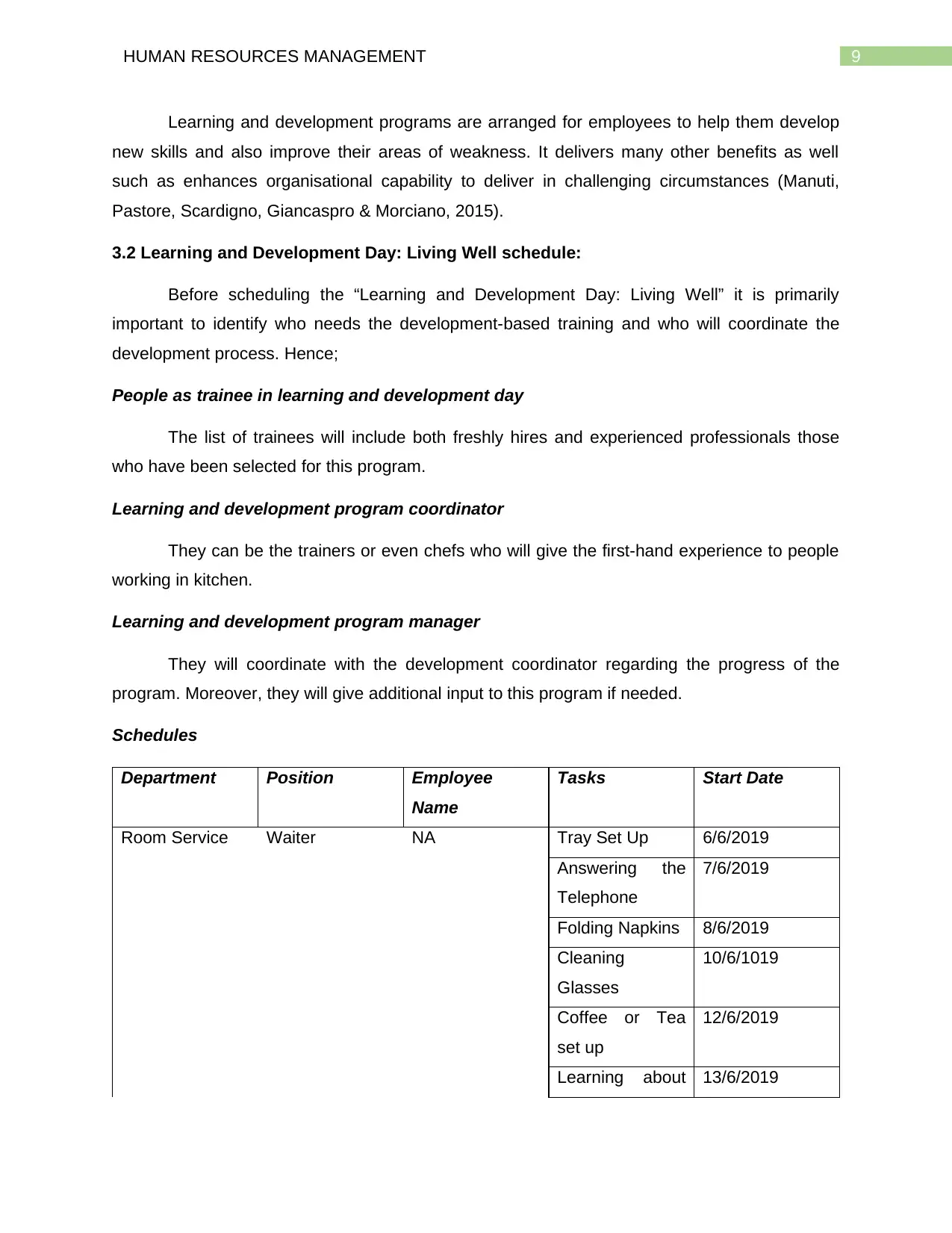
9HUMAN RESOURCES MANAGEMENT
Learning and development programs are arranged for employees to help them develop
new skills and also improve their areas of weakness. It delivers many other benefits as well
such as enhances organisational capability to deliver in challenging circumstances (Manuti,
Pastore, Scardigno, Giancaspro & Morciano, 2015).
3.2 Learning and Development Day: Living Well schedule:
Before scheduling the “Learning and Development Day: Living Well” it is primarily
important to identify who needs the development-based training and who will coordinate the
development process. Hence;
People as trainee in learning and development day
The list of trainees will include both freshly hires and experienced professionals those
who have been selected for this program.
Learning and development program coordinator
They can be the trainers or even chefs who will give the first-hand experience to people
working in kitchen.
Learning and development program manager
They will coordinate with the development coordinator regarding the progress of the
program. Moreover, they will give additional input to this program if needed.
Schedules
Department Position Employee
Name
Tasks Start Date
Room Service Waiter NA Tray Set Up 6/6/2019
Answering the
Telephone
7/6/2019
Folding Napkins 8/6/2019
Cleaning
Glasses
10/6/1019
Coffee or Tea
set up
12/6/2019
Learning about 13/6/2019
Learning and development programs are arranged for employees to help them develop
new skills and also improve their areas of weakness. It delivers many other benefits as well
such as enhances organisational capability to deliver in challenging circumstances (Manuti,
Pastore, Scardigno, Giancaspro & Morciano, 2015).
3.2 Learning and Development Day: Living Well schedule:
Before scheduling the “Learning and Development Day: Living Well” it is primarily
important to identify who needs the development-based training and who will coordinate the
development process. Hence;
People as trainee in learning and development day
The list of trainees will include both freshly hires and experienced professionals those
who have been selected for this program.
Learning and development program coordinator
They can be the trainers or even chefs who will give the first-hand experience to people
working in kitchen.
Learning and development program manager
They will coordinate with the development coordinator regarding the progress of the
program. Moreover, they will give additional input to this program if needed.
Schedules
Department Position Employee
Name
Tasks Start Date
Room Service Waiter NA Tray Set Up 6/6/2019
Answering the
Telephone
7/6/2019
Folding Napkins 8/6/2019
Cleaning
Glasses
10/6/1019
Coffee or Tea
set up
12/6/2019
Learning about 13/6/2019
Secure Best Marks with AI Grader
Need help grading? Try our AI Grader for instant feedback on your assignments.
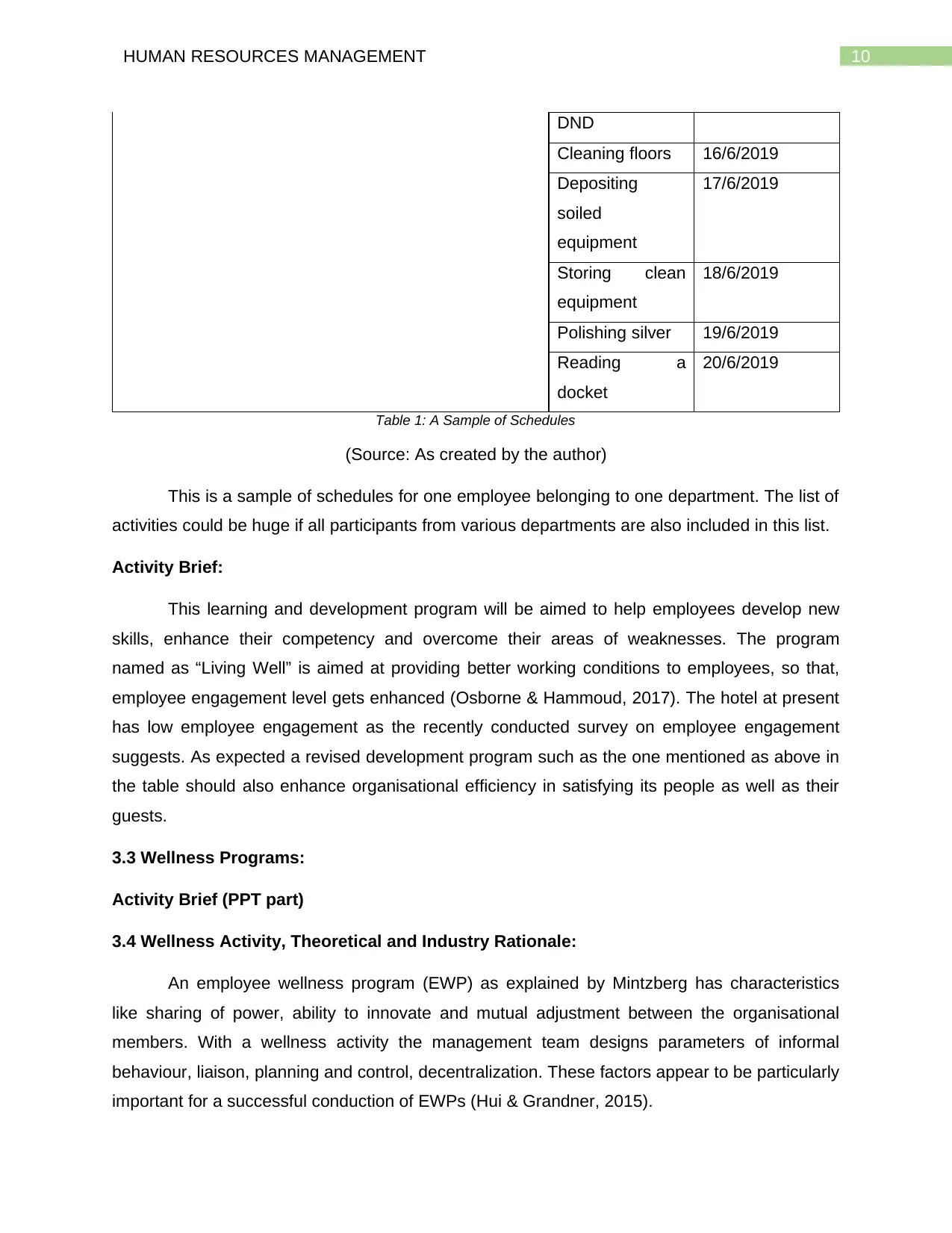
10HUMAN RESOURCES MANAGEMENT
DND
Cleaning floors 16/6/2019
Depositing
soiled
equipment
17/6/2019
Storing clean
equipment
18/6/2019
Polishing silver 19/6/2019
Reading a
docket
20/6/2019
Table 1: A Sample of Schedules
(Source: As created by the author)
This is a sample of schedules for one employee belonging to one department. The list of
activities could be huge if all participants from various departments are also included in this list.
Activity Brief:
This learning and development program will be aimed to help employees develop new
skills, enhance their competency and overcome their areas of weaknesses. The program
named as “Living Well” is aimed at providing better working conditions to employees, so that,
employee engagement level gets enhanced (Osborne & Hammoud, 2017). The hotel at present
has low employee engagement as the recently conducted survey on employee engagement
suggests. As expected a revised development program such as the one mentioned as above in
the table should also enhance organisational efficiency in satisfying its people as well as their
guests.
3.3 Wellness Programs:
Activity Brief (PPT part)
3.4 Wellness Activity, Theoretical and Industry Rationale:
An employee wellness program (EWP) as explained by Mintzberg has characteristics
like sharing of power, ability to innovate and mutual adjustment between the organisational
members. With a wellness activity the management team designs parameters of informal
behaviour, liaison, planning and control, decentralization. These factors appear to be particularly
important for a successful conduction of EWPs (Hui & Grandner, 2015).
DND
Cleaning floors 16/6/2019
Depositing
soiled
equipment
17/6/2019
Storing clean
equipment
18/6/2019
Polishing silver 19/6/2019
Reading a
docket
20/6/2019
Table 1: A Sample of Schedules
(Source: As created by the author)
This is a sample of schedules for one employee belonging to one department. The list of
activities could be huge if all participants from various departments are also included in this list.
Activity Brief:
This learning and development program will be aimed to help employees develop new
skills, enhance their competency and overcome their areas of weaknesses. The program
named as “Living Well” is aimed at providing better working conditions to employees, so that,
employee engagement level gets enhanced (Osborne & Hammoud, 2017). The hotel at present
has low employee engagement as the recently conducted survey on employee engagement
suggests. As expected a revised development program such as the one mentioned as above in
the table should also enhance organisational efficiency in satisfying its people as well as their
guests.
3.3 Wellness Programs:
Activity Brief (PPT part)
3.4 Wellness Activity, Theoretical and Industry Rationale:
An employee wellness program (EWP) as explained by Mintzberg has characteristics
like sharing of power, ability to innovate and mutual adjustment between the organisational
members. With a wellness activity the management team designs parameters of informal
behaviour, liaison, planning and control, decentralization. These factors appear to be particularly
important for a successful conduction of EWPs (Hui & Grandner, 2015).
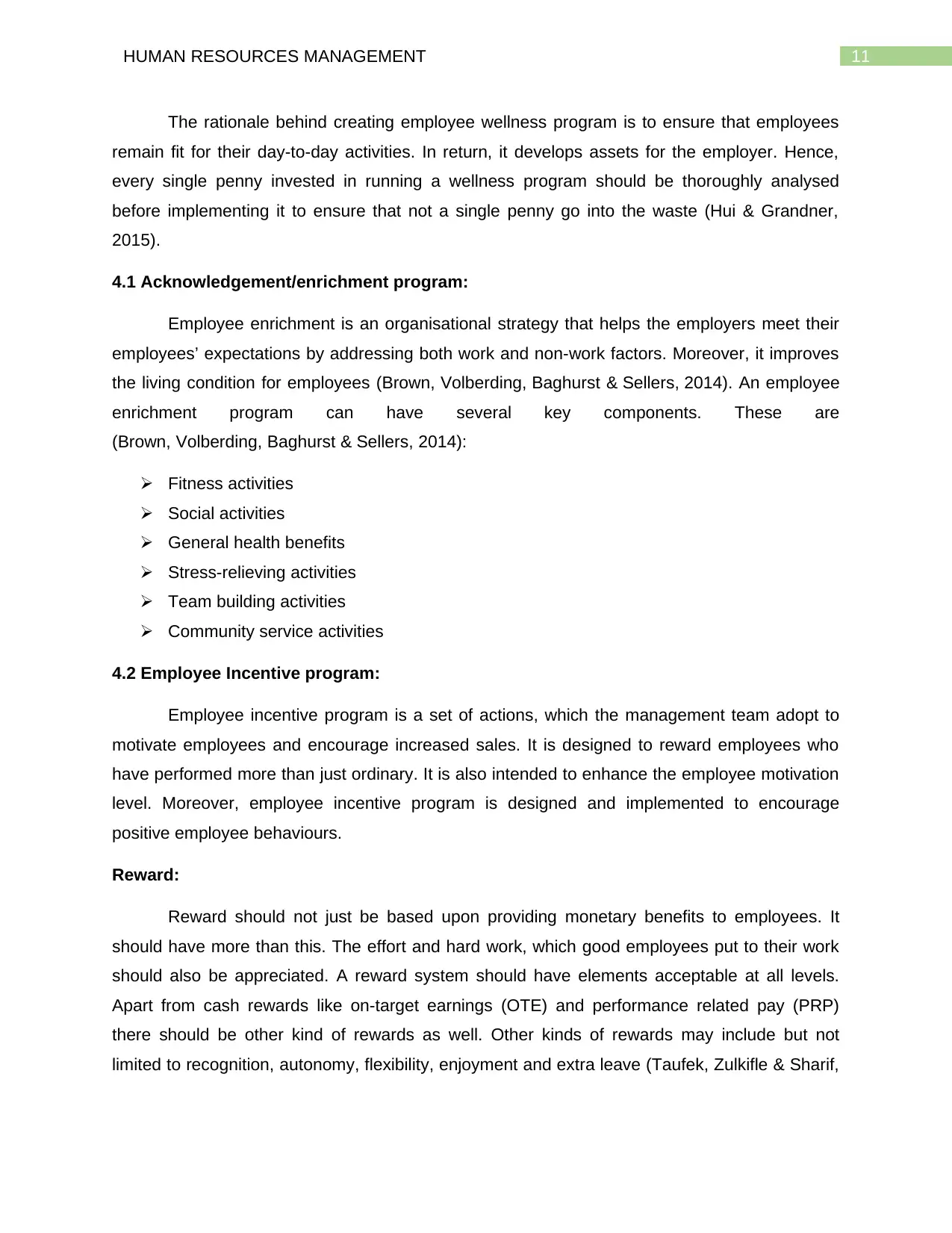
11HUMAN RESOURCES MANAGEMENT
The rationale behind creating employee wellness program is to ensure that employees
remain fit for their day-to-day activities. In return, it develops assets for the employer. Hence,
every single penny invested in running a wellness program should be thoroughly analysed
before implementing it to ensure that not a single penny go into the waste (Hui & Grandner,
2015).
4.1 Acknowledgement/enrichment program:
Employee enrichment is an organisational strategy that helps the employers meet their
employees’ expectations by addressing both work and non-work factors. Moreover, it improves
the living condition for employees (Brown, Volberding, Baghurst & Sellers, 2014). An employee
enrichment program can have several key components. These are
(Brown, Volberding, Baghurst & Sellers, 2014):
Fitness activities
Social activities
General health benefits
Stress-relieving activities
Team building activities
Community service activities
4.2 Employee Incentive program:
Employee incentive program is a set of actions, which the management team adopt to
motivate employees and encourage increased sales. It is designed to reward employees who
have performed more than just ordinary. It is also intended to enhance the employee motivation
level. Moreover, employee incentive program is designed and implemented to encourage
positive employee behaviours.
Reward:
Reward should not just be based upon providing monetary benefits to employees. It
should have more than this. The effort and hard work, which good employees put to their work
should also be appreciated. A reward system should have elements acceptable at all levels.
Apart from cash rewards like on-target earnings (OTE) and performance related pay (PRP)
there should be other kind of rewards as well. Other kinds of rewards may include but not
limited to recognition, autonomy, flexibility, enjoyment and extra leave (Taufek, Zulkifle & Sharif,
The rationale behind creating employee wellness program is to ensure that employees
remain fit for their day-to-day activities. In return, it develops assets for the employer. Hence,
every single penny invested in running a wellness program should be thoroughly analysed
before implementing it to ensure that not a single penny go into the waste (Hui & Grandner,
2015).
4.1 Acknowledgement/enrichment program:
Employee enrichment is an organisational strategy that helps the employers meet their
employees’ expectations by addressing both work and non-work factors. Moreover, it improves
the living condition for employees (Brown, Volberding, Baghurst & Sellers, 2014). An employee
enrichment program can have several key components. These are
(Brown, Volberding, Baghurst & Sellers, 2014):
Fitness activities
Social activities
General health benefits
Stress-relieving activities
Team building activities
Community service activities
4.2 Employee Incentive program:
Employee incentive program is a set of actions, which the management team adopt to
motivate employees and encourage increased sales. It is designed to reward employees who
have performed more than just ordinary. It is also intended to enhance the employee motivation
level. Moreover, employee incentive program is designed and implemented to encourage
positive employee behaviours.
Reward:
Reward should not just be based upon providing monetary benefits to employees. It
should have more than this. The effort and hard work, which good employees put to their work
should also be appreciated. A reward system should have elements acceptable at all levels.
Apart from cash rewards like on-target earnings (OTE) and performance related pay (PRP)
there should be other kind of rewards as well. Other kinds of rewards may include but not
limited to recognition, autonomy, flexibility, enjoyment and extra leave (Taufek, Zulkifle & Sharif,
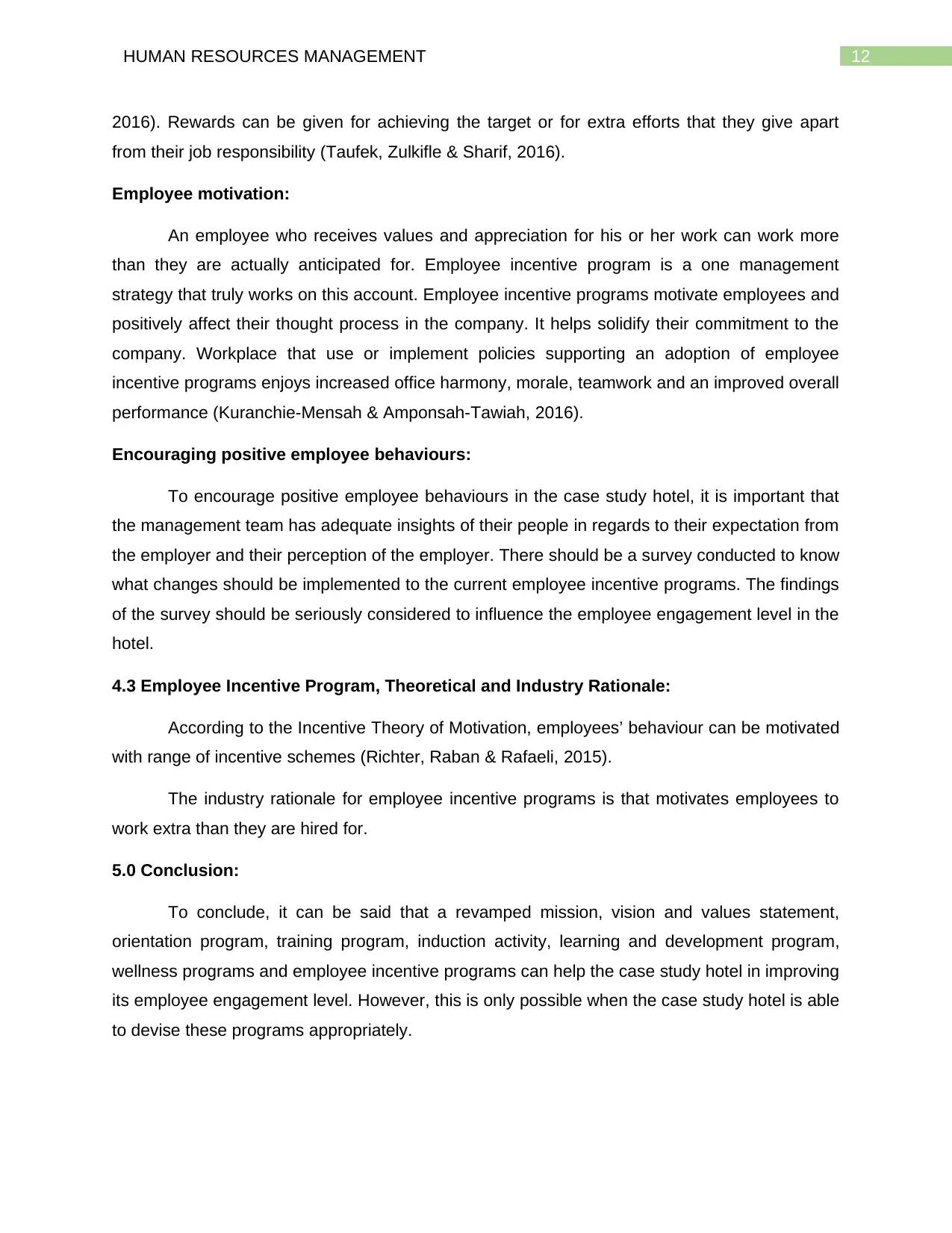
12HUMAN RESOURCES MANAGEMENT
2016). Rewards can be given for achieving the target or for extra efforts that they give apart
from their job responsibility (Taufek, Zulkifle & Sharif, 2016).
Employee motivation:
An employee who receives values and appreciation for his or her work can work more
than they are actually anticipated for. Employee incentive program is a one management
strategy that truly works on this account. Employee incentive programs motivate employees and
positively affect their thought process in the company. It helps solidify their commitment to the
company. Workplace that use or implement policies supporting an adoption of employee
incentive programs enjoys increased office harmony, morale, teamwork and an improved overall
performance (Kuranchie-Mensah & Amponsah-Tawiah, 2016).
Encouraging positive employee behaviours:
To encourage positive employee behaviours in the case study hotel, it is important that
the management team has adequate insights of their people in regards to their expectation from
the employer and their perception of the employer. There should be a survey conducted to know
what changes should be implemented to the current employee incentive programs. The findings
of the survey should be seriously considered to influence the employee engagement level in the
hotel.
4.3 Employee Incentive Program, Theoretical and Industry Rationale:
According to the Incentive Theory of Motivation, employees’ behaviour can be motivated
with range of incentive schemes (Richter, Raban & Rafaeli, 2015).
The industry rationale for employee incentive programs is that motivates employees to
work extra than they are hired for.
5.0 Conclusion:
To conclude, it can be said that a revamped mission, vision and values statement,
orientation program, training program, induction activity, learning and development program,
wellness programs and employee incentive programs can help the case study hotel in improving
its employee engagement level. However, this is only possible when the case study hotel is able
to devise these programs appropriately.
2016). Rewards can be given for achieving the target or for extra efforts that they give apart
from their job responsibility (Taufek, Zulkifle & Sharif, 2016).
Employee motivation:
An employee who receives values and appreciation for his or her work can work more
than they are actually anticipated for. Employee incentive program is a one management
strategy that truly works on this account. Employee incentive programs motivate employees and
positively affect their thought process in the company. It helps solidify their commitment to the
company. Workplace that use or implement policies supporting an adoption of employee
incentive programs enjoys increased office harmony, morale, teamwork and an improved overall
performance (Kuranchie-Mensah & Amponsah-Tawiah, 2016).
Encouraging positive employee behaviours:
To encourage positive employee behaviours in the case study hotel, it is important that
the management team has adequate insights of their people in regards to their expectation from
the employer and their perception of the employer. There should be a survey conducted to know
what changes should be implemented to the current employee incentive programs. The findings
of the survey should be seriously considered to influence the employee engagement level in the
hotel.
4.3 Employee Incentive Program, Theoretical and Industry Rationale:
According to the Incentive Theory of Motivation, employees’ behaviour can be motivated
with range of incentive schemes (Richter, Raban & Rafaeli, 2015).
The industry rationale for employee incentive programs is that motivates employees to
work extra than they are hired for.
5.0 Conclusion:
To conclude, it can be said that a revamped mission, vision and values statement,
orientation program, training program, induction activity, learning and development program,
wellness programs and employee incentive programs can help the case study hotel in improving
its employee engagement level. However, this is only possible when the case study hotel is able
to devise these programs appropriately.
Paraphrase This Document
Need a fresh take? Get an instant paraphrase of this document with our AI Paraphraser
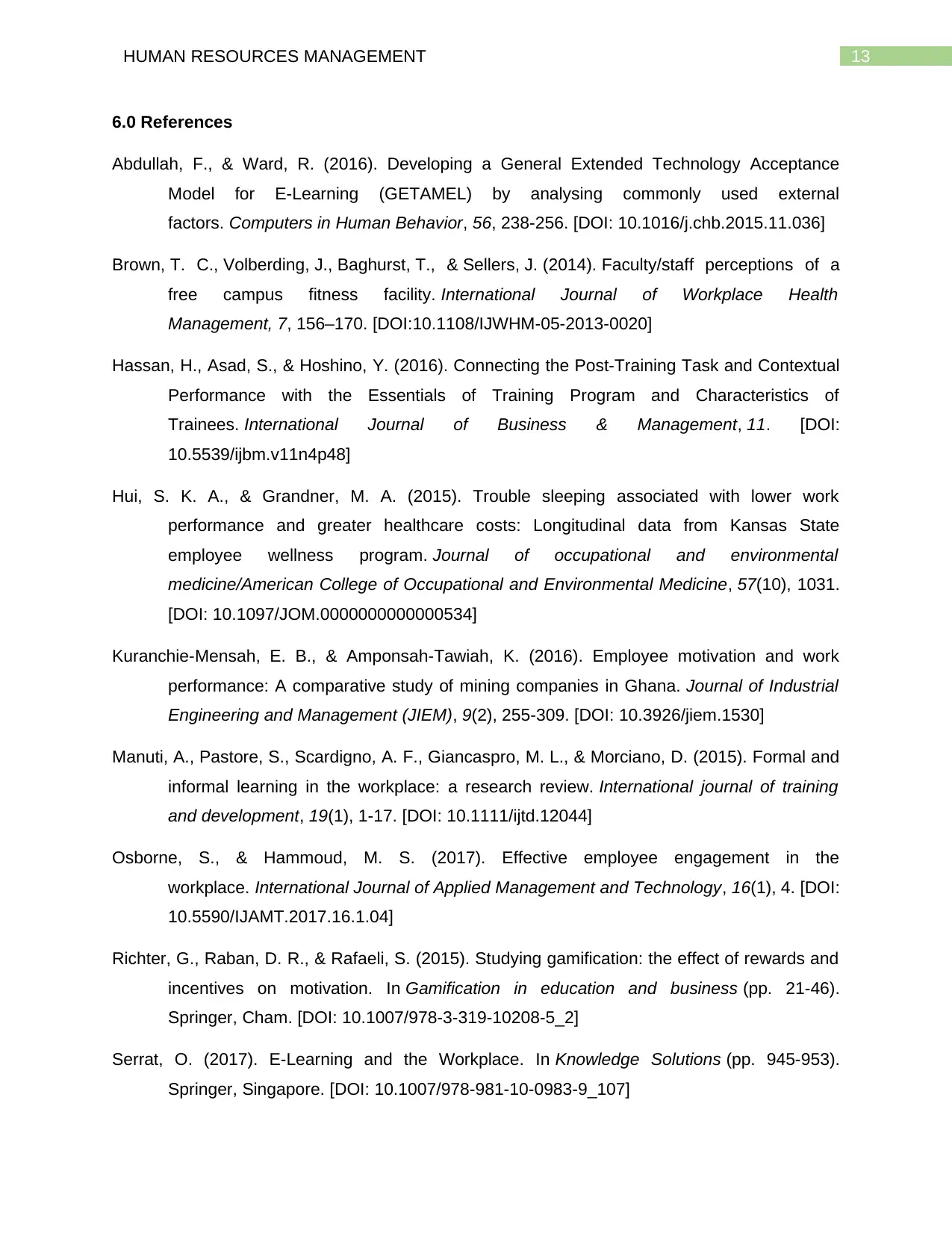
13HUMAN RESOURCES MANAGEMENT
6.0 References
Abdullah, F., & Ward, R. (2016). Developing a General Extended Technology Acceptance
Model for E-Learning (GETAMEL) by analysing commonly used external
factors. Computers in Human Behavior, 56, 238-256. [DOI: 10.1016/j.chb.2015.11.036]
Brown, T. C., Volberding, J., Baghurst, T., & Sellers, J. (2014). Faculty/staff perceptions of a
free campus fitness facility. International Journal of Workplace Health
Management, 7, 156–170. [DOI:10.1108/IJWHM-05-2013-0020]
Hassan, H., Asad, S., & Hoshino, Y. (2016). Connecting the Post-Training Task and Contextual
Performance with the Essentials of Training Program and Characteristics of
Trainees. International Journal of Business & Management, 11. [DOI:
10.5539/ijbm.v11n4p48]
Hui, S. K. A., & Grandner, M. A. (2015). Trouble sleeping associated with lower work
performance and greater healthcare costs: Longitudinal data from Kansas State
employee wellness program. Journal of occupational and environmental
medicine/American College of Occupational and Environmental Medicine, 57(10), 1031.
[DOI: 10.1097/JOM.0000000000000534]
Kuranchie-Mensah, E. B., & Amponsah-Tawiah, K. (2016). Employee motivation and work
performance: A comparative study of mining companies in Ghana. Journal of Industrial
Engineering and Management (JIEM), 9(2), 255-309. [DOI: 10.3926/jiem.1530]
Manuti, A., Pastore, S., Scardigno, A. F., Giancaspro, M. L., & Morciano, D. (2015). Formal and
informal learning in the workplace: a research review. International journal of training
and development, 19(1), 1-17. [DOI: 10.1111/ijtd.12044]
Osborne, S., & Hammoud, M. S. (2017). Effective employee engagement in the
workplace. International Journal of Applied Management and Technology, 16(1), 4. [DOI:
10.5590/IJAMT.2017.16.1.04]
Richter, G., Raban, D. R., & Rafaeli, S. (2015). Studying gamification: the effect of rewards and
incentives on motivation. In Gamification in education and business (pp. 21-46).
Springer, Cham. [DOI: 10.1007/978-3-319-10208-5_2]
Serrat, O. (2017). E-Learning and the Workplace. In Knowledge Solutions (pp. 945-953).
Springer, Singapore. [DOI: 10.1007/978-981-10-0983-9_107]
6.0 References
Abdullah, F., & Ward, R. (2016). Developing a General Extended Technology Acceptance
Model for E-Learning (GETAMEL) by analysing commonly used external
factors. Computers in Human Behavior, 56, 238-256. [DOI: 10.1016/j.chb.2015.11.036]
Brown, T. C., Volberding, J., Baghurst, T., & Sellers, J. (2014). Faculty/staff perceptions of a
free campus fitness facility. International Journal of Workplace Health
Management, 7, 156–170. [DOI:10.1108/IJWHM-05-2013-0020]
Hassan, H., Asad, S., & Hoshino, Y. (2016). Connecting the Post-Training Task and Contextual
Performance with the Essentials of Training Program and Characteristics of
Trainees. International Journal of Business & Management, 11. [DOI:
10.5539/ijbm.v11n4p48]
Hui, S. K. A., & Grandner, M. A. (2015). Trouble sleeping associated with lower work
performance and greater healthcare costs: Longitudinal data from Kansas State
employee wellness program. Journal of occupational and environmental
medicine/American College of Occupational and Environmental Medicine, 57(10), 1031.
[DOI: 10.1097/JOM.0000000000000534]
Kuranchie-Mensah, E. B., & Amponsah-Tawiah, K. (2016). Employee motivation and work
performance: A comparative study of mining companies in Ghana. Journal of Industrial
Engineering and Management (JIEM), 9(2), 255-309. [DOI: 10.3926/jiem.1530]
Manuti, A., Pastore, S., Scardigno, A. F., Giancaspro, M. L., & Morciano, D. (2015). Formal and
informal learning in the workplace: a research review. International journal of training
and development, 19(1), 1-17. [DOI: 10.1111/ijtd.12044]
Osborne, S., & Hammoud, M. S. (2017). Effective employee engagement in the
workplace. International Journal of Applied Management and Technology, 16(1), 4. [DOI:
10.5590/IJAMT.2017.16.1.04]
Richter, G., Raban, D. R., & Rafaeli, S. (2015). Studying gamification: the effect of rewards and
incentives on motivation. In Gamification in education and business (pp. 21-46).
Springer, Cham. [DOI: 10.1007/978-3-319-10208-5_2]
Serrat, O. (2017). E-Learning and the Workplace. In Knowledge Solutions (pp. 945-953).
Springer, Singapore. [DOI: 10.1007/978-981-10-0983-9_107]
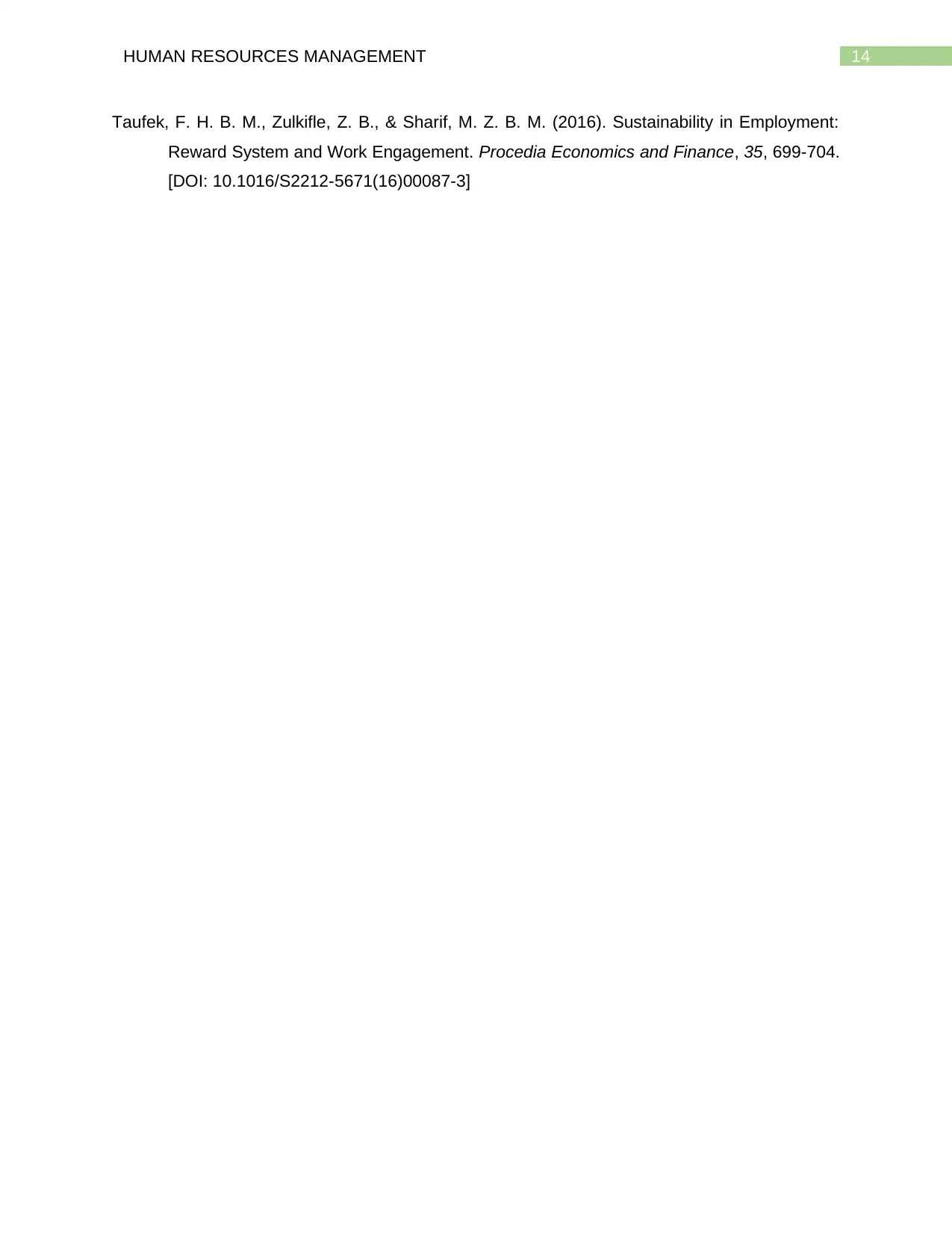
14HUMAN RESOURCES MANAGEMENT
Taufek, F. H. B. M., Zulkifle, Z. B., & Sharif, M. Z. B. M. (2016). Sustainability in Employment:
Reward System and Work Engagement. Procedia Economics and Finance, 35, 699-704.
[DOI: 10.1016/S2212-5671(16)00087-3]
Taufek, F. H. B. M., Zulkifle, Z. B., & Sharif, M. Z. B. M. (2016). Sustainability in Employment:
Reward System and Work Engagement. Procedia Economics and Finance, 35, 699-704.
[DOI: 10.1016/S2212-5671(16)00087-3]
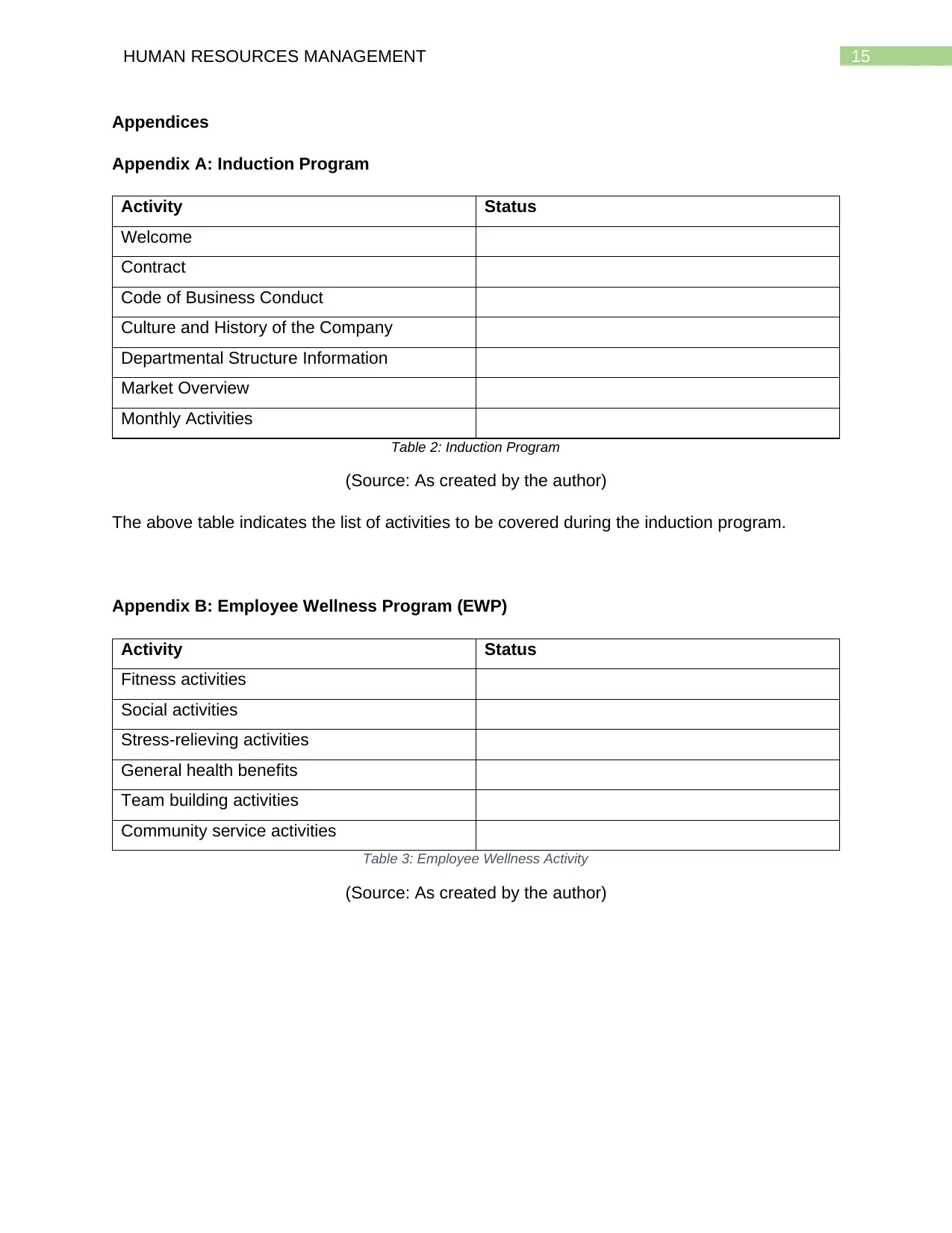
15HUMAN RESOURCES MANAGEMENT
Appendices
Appendix A: Induction Program
Activity Status
Welcome
Contract
Code of Business Conduct
Culture and History of the Company
Departmental Structure Information
Market Overview
Monthly Activities
Table 2: Induction Program
(Source: As created by the author)
The above table indicates the list of activities to be covered during the induction program.
Appendix B: Employee Wellness Program (EWP)
Activity Status
Fitness activities
Social activities
Stress-relieving activities
General health benefits
Team building activities
Community service activities
Table 3: Employee Wellness Activity
(Source: As created by the author)
Appendices
Appendix A: Induction Program
Activity Status
Welcome
Contract
Code of Business Conduct
Culture and History of the Company
Departmental Structure Information
Market Overview
Monthly Activities
Table 2: Induction Program
(Source: As created by the author)
The above table indicates the list of activities to be covered during the induction program.
Appendix B: Employee Wellness Program (EWP)
Activity Status
Fitness activities
Social activities
Stress-relieving activities
General health benefits
Team building activities
Community service activities
Table 3: Employee Wellness Activity
(Source: As created by the author)
1 out of 16
Related Documents
Your All-in-One AI-Powered Toolkit for Academic Success.
+13062052269
info@desklib.com
Available 24*7 on WhatsApp / Email
![[object Object]](/_next/static/media/star-bottom.7253800d.svg)
Unlock your academic potential
© 2024 | Zucol Services PVT LTD | All rights reserved.





